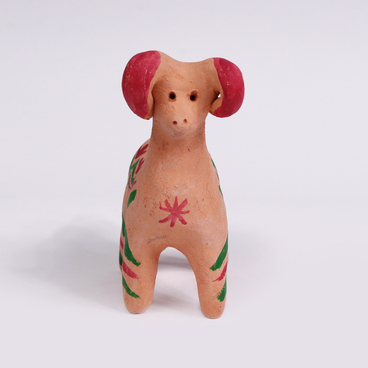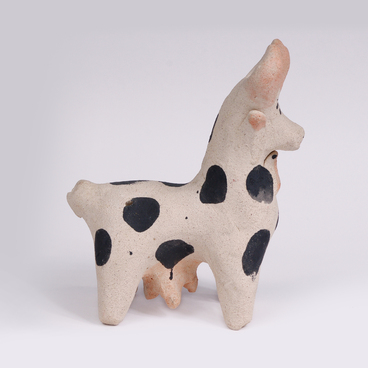This toy was found during excavations in Stary Oskol. The Goncharova sisters called such items ‘koniks’ (‘small horses’). This type of toys is one of the oldest — it appeared in Oskol in the 15th century and has hardly changed since that time. Researchers attribute this particular figure to the 20th century. Unfortunately, it has not been preserved completely: the horse lacks two hind legs.
The toy is made of white-burning clay. Clay lying on the surface — ‘peskusha’ — has been collected to make toys since olden times. After firing, it becomes white with a slight touch of creamy color. Artists usually added a little ‘black, ’ more pliant clay to it.
The horse is one of the ancient symbols in Russian pagan cults. This image is often found in Slavic burials of the 6th — 8th centuries and during the excavations of Old Russian cities of the 10th — 14th centuries. The horse was considered the Sun’s servant, it was said to bring good grace to people. Around the 15th — 16th centuries, Stary Oskol horses were made with long necks, so they resembled the old Moscow toy. Judging by the archaeological findings, in the old days, children from Stary Oskol were not very interested in a horse toy without a rider. In the 16th — 18th centuries, masters made horses with clay horsemen right away. The figures looked quite belligerent, so they were often called “generals.”
The art expert Elena Andrusenko divided toys into four conventional types: rattles, whistles, sculptures, and items imitating “adult” dishes. She wrote that it was possible to identify,
The toy is made of white-burning clay. Clay lying on the surface — ‘peskusha’ — has been collected to make toys since olden times. After firing, it becomes white with a slight touch of creamy color. Artists usually added a little ‘black, ’ more pliant clay to it.
The horse is one of the ancient symbols in Russian pagan cults. This image is often found in Slavic burials of the 6th — 8th centuries and during the excavations of Old Russian cities of the 10th — 14th centuries. The horse was considered the Sun’s servant, it was said to bring good grace to people. Around the 15th — 16th centuries, Stary Oskol horses were made with long necks, so they resembled the old Moscow toy. Judging by the archaeological findings, in the old days, children from Stary Oskol were not very interested in a horse toy without a rider. In the 16th — 18th centuries, masters made horses with clay horsemen right away. The figures looked quite belligerent, so they were often called “generals.”
The art expert Elena Andrusenko divided toys into four conventional types: rattles, whistles, sculptures, and items imitating “adult” dishes. She wrote that it was possible to identify,

